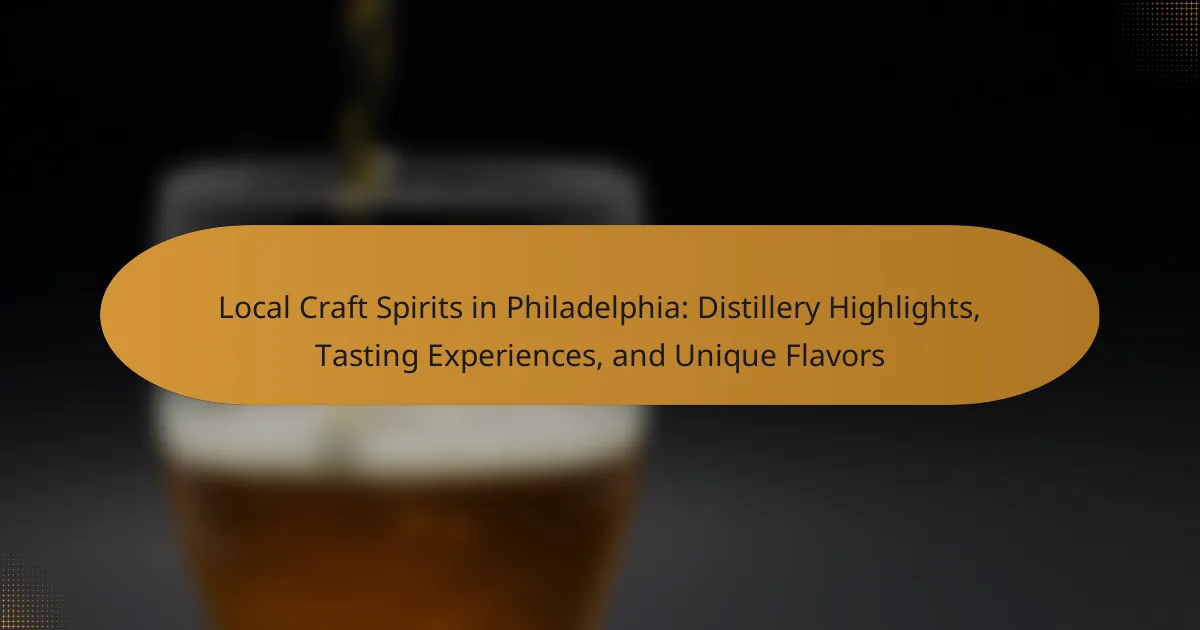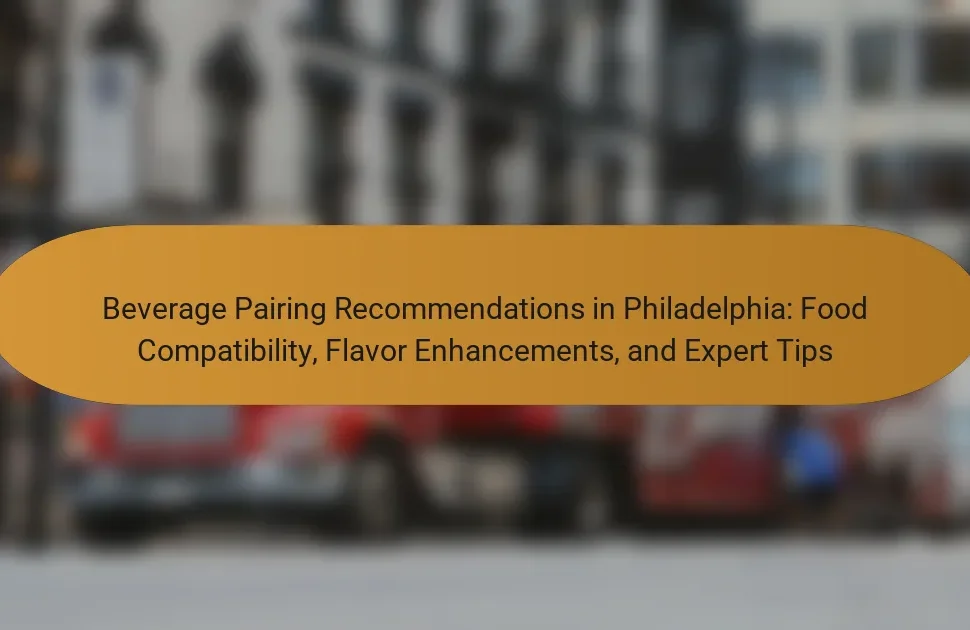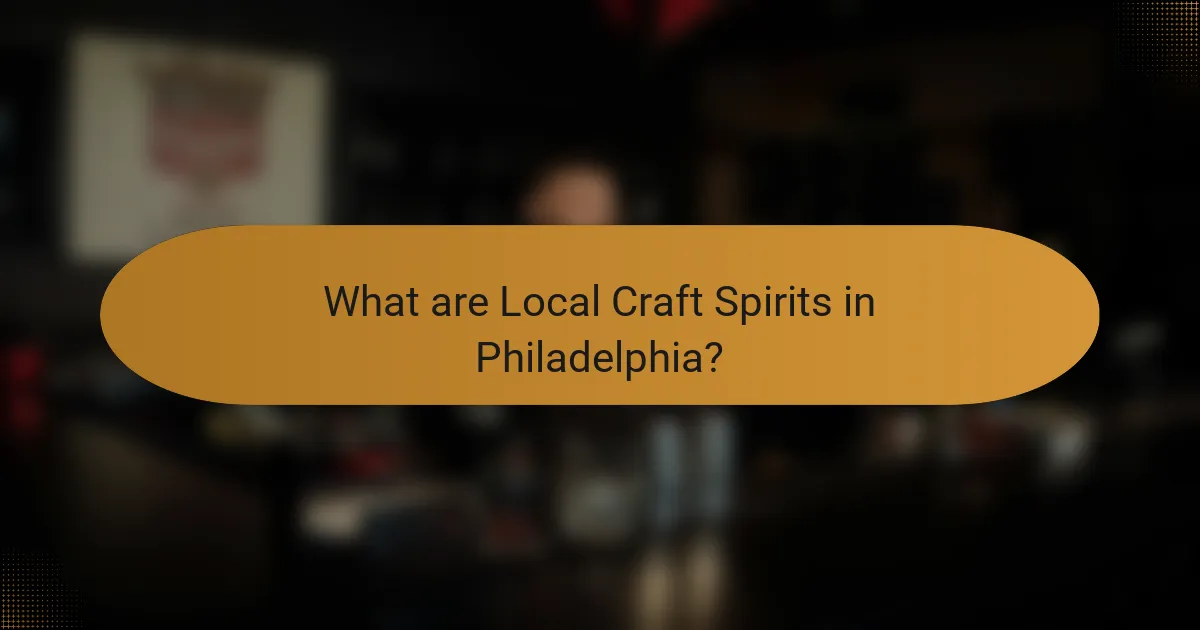
What are Local Craft Spirits in Philadelphia?
Local craft spirits in Philadelphia are small-batch alcoholic beverages produced by local distilleries. These spirits often include gin, whiskey, rum, and vodka. They are crafted using traditional methods and locally sourced ingredients. The Philadelphia craft spirit scene has grown significantly in recent years. Distilleries like New Liberty Distillery and Philadelphia Distilling showcase unique flavors and innovative techniques. Many of these establishments offer tasting experiences for visitors. Local craft spirits reflect the region’s rich history and culture. They contribute to the city’s vibrant beverage landscape and support local economies.
How do local craft spirits differ from mass-produced options?
Local craft spirits differ from mass-produced options primarily in their production methods and ingredient sourcing. Craft spirits are typically made in small batches, allowing for greater attention to detail and quality. This approach often results in unique flavors and profiles that reflect local ingredients and traditions. In contrast, mass-produced spirits prioritize efficiency and consistency, often using additives and artificial flavors to achieve a uniform taste.
Craft distilleries often emphasize artisanal techniques, such as pot still distillation, which can enhance the spirit’s character. Many craft producers also focus on sustainable practices, sourcing grains and botanicals from local farms. This connection to the community can lead to distinctive products that resonate with regional culture.
Statistics indicate that the craft spirits market has been growing significantly, with the American Craft Spirits Association reporting a 20% increase in craft distilleries from 2019 to 2020. This growth reflects a consumer preference for authenticity and quality over mass-produced alternatives.
What defines the quality of local craft spirits?
The quality of local craft spirits is defined by several key factors. These include the ingredients used, production methods, and the distillation process. High-quality craft spirits often utilize locally sourced ingredients. This enhances flavor profiles and supports local agriculture. Traditional distillation methods are also crucial. They often involve small-batch production, allowing for greater control over quality.
Moreover, the aging process significantly impacts quality. Spirits aged in carefully selected barrels develop complex flavors. The expertise of the distiller plays a vital role as well. Skilled distillers can create unique and high-quality products.
Consumer feedback and awards can serve as indicators of quality. Many local craft spirits have received recognition in competitions. This demonstrates their excellence in taste and craftsmanship.
What are the main ingredients used in local craft spirits?
The main ingredients used in local craft spirits include grains, fruits, and botanicals. Grains such as barley, corn, and rye are commonly used for distillation. These grains provide the base for spirits like whiskey and vodka. Fruits like apples, peaches, and berries are often utilized in the production of flavored spirits and liqueurs. Botanicals, including herbs and spices, are essential for crafting gin and other aromatic spirits. Local distilleries may also incorporate unique regional ingredients, reflecting the local terroir. For instance, some distilleries in Philadelphia use locally sourced honey or spices to create distinct flavors. This focus on local ingredients enhances the authenticity and uniqueness of the craft spirits produced in the area.
Why is Philadelphia a hub for craft distilleries?
Philadelphia is a hub for craft distilleries due to its rich history and strong local culture. The city has a vibrant food and beverage scene that supports artisanal producers. Pennsylvania’s laws favor small distilleries, allowing easier access to licenses. The region’s agricultural resources provide fresh, local ingredients for distillation. Additionally, Philadelphia’s proximity to major markets enhances distribution opportunities for craft spirits. The city’s diverse population also contributes to innovative flavor profiles and unique products. As of 2023, there are over 20 craft distilleries in the city, reflecting its growing prominence in the industry.
What historical factors contributed to Philadelphia’s distilling culture?
Philadelphia’s distilling culture developed due to several historical factors. The city was a major port in the 18th century, facilitating the import of raw materials. This included grains and molasses, essential for distillation. Additionally, the region’s agricultural abundance provided local ingredients for distillers. The establishment of early distilleries in the 1700s contributed to a growing industry. Philadelphia’s diverse immigrant population also influenced the distilling practices. Different cultural traditions introduced unique recipes and techniques. The American Revolution and subsequent economic changes further shaped the landscape of distilling in the city. Regulations and taxes on alcohol production evolved, impacting local distillers. These historical elements combined to create a rich distilling heritage in Philadelphia.
How do local regulations impact craft distilling in Philadelphia?
Local regulations significantly impact craft distilling in Philadelphia. These regulations dictate licensing requirements for distilleries. They also establish production limits and operational hours. Compliance with health and safety standards is mandatory. Zoning laws affect where distilleries can operate. Taxes on spirits influence pricing and profitability. Additionally, regulations can determine distribution channels for products. Overall, these factors shape the local craft distilling landscape.
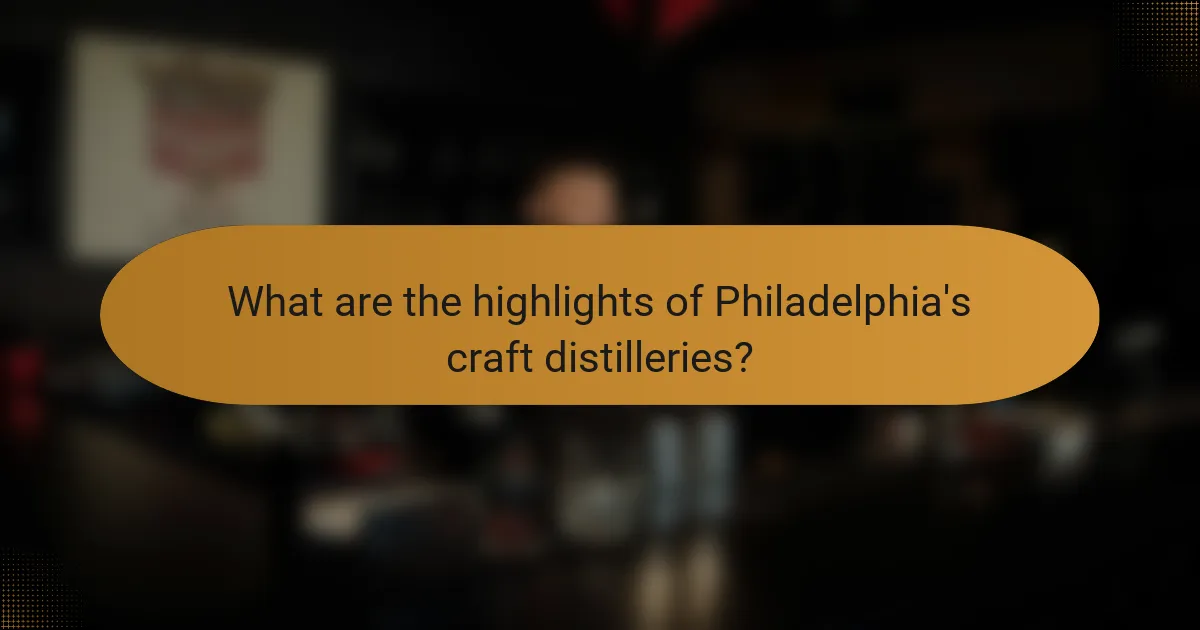
What are the highlights of Philadelphia’s craft distilleries?
Philadelphia’s craft distilleries are known for their innovative spirits and unique flavors. They produce a variety of products including whiskey, gin, and rum. Many distilleries focus on locally sourced ingredients, enhancing their regional character. Notable distilleries include New Liberty Distillery, known for its rye whiskey, and Stateside Urbancraft Vodka, celebrated for its smooth profile. Distilleries often offer tasting experiences that educate visitors on the distillation process. Events and tours are common, providing insights into the craft. Philadelphia’s craft distilling scene contributes to the local economy and culture. The city hosts the annual Philadelphia Distillery Festival, showcasing local producers.
Which distilleries are considered must-visit in Philadelphia?
The must-visit distilleries in Philadelphia include Bluecoat American Dry Gin, which is known for its unique botanical blend. Another notable distillery is Philadelphia Distilling, famous for its craft spirits and innovative flavors. Stateside Urbancraft Vodka is also a top destination, recognized for its locally sourced ingredients. Lastly, New Liberty Distillery offers a range of artisanal spirits, emphasizing traditional distilling methods. These distilleries contribute significantly to Philadelphia’s vibrant craft spirits scene, attracting both locals and tourists.
What unique offerings do these distilleries provide?
Local distilleries in Philadelphia provide unique offerings such as artisanal spirits crafted from locally sourced ingredients. Each distillery often features signature blends that reflect regional flavors. Many offer exclusive tasting experiences that allow patrons to sample limited-edition releases. Some distilleries conduct guided tours, showcasing their production processes. Collaborations with local farms enhance the authenticity of their products. Seasonal variations in their offerings highlight the changing local landscape. Custom bottling options are also available for special occasions. These unique attributes distinguish Philadelphia distilleries in the craft spirits market.
How do the distillery tours enhance the tasting experience?
Distillery tours enhance the tasting experience by providing in-depth knowledge of the production process. Visitors learn about the ingredients and techniques used in crafting spirits. This context enriches their appreciation of the flavors. Engaging with distillers adds a personal touch to the tasting. Guests can ask questions and gain insights directly from the makers. Additionally, tours often include exclusive tastings of limited releases. This access to unique products elevates the overall experience. The combination of education and personal interaction makes the tasting more memorable.
What awards or recognitions have Philadelphia distilleries received?
Philadelphia distilleries have received numerous awards and recognitions for their craft spirits. For instance, Philadelphia Distilling won several medals at the San Francisco World Spirits Competition. Their Bluecoat Gin has been awarded a Double Gold medal. New Liberty Distillery has also gained recognition, receiving a Gold medal for their Kinsey Whiskey. Other local distilleries, like Stateside Urbancraft Vodka, have been honored with accolades at various spirits competitions. These recognitions highlight the quality and innovation present in Philadelphia’s distilling scene.
How do these accolades influence consumer choices?
Accolades significantly influence consumer choices by enhancing the perceived quality of local craft spirits. Consumers often rely on awards and recognitions as indicators of excellence. A study by the Journal of Consumer Research found that products with accolades are viewed as more trustworthy. This trust can lead to increased sales and brand loyalty. Furthermore, accolades can create a sense of urgency among consumers. They may feel compelled to purchase award-winning spirits before they become unavailable. Overall, accolades serve as a powerful marketing tool that shapes consumer preferences in the craft spirits market.
What are the standout products that have won awards?
The standout products that have won awards in Philadelphia’s local craft spirits scene include Bluecoat Gin, which received multiple accolades for its unique botanical blend. Another notable product is Dad’s Hat Rye Whiskey, recognized for its traditional Pennsylvania-style rye. Additionally, Philadelphia Distilling’s Vesper Gin has earned awards for its innovative flavor profile. These products have been acknowledged at various spirits competitions, showcasing the quality and creativity of local distillers.
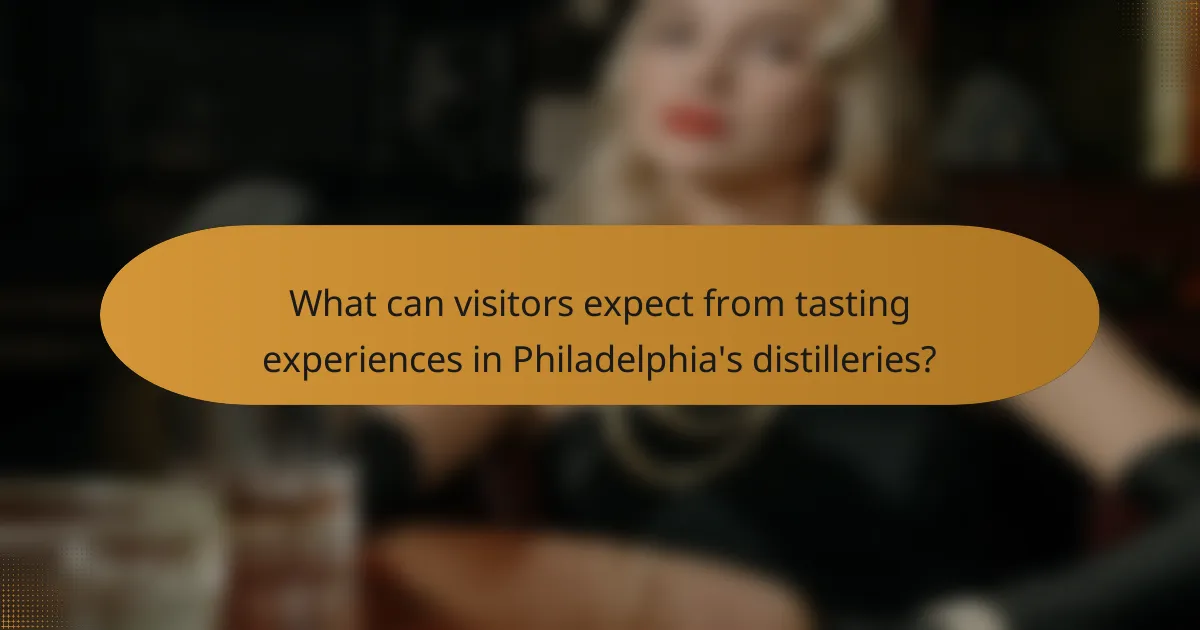
What can visitors expect from tasting experiences in Philadelphia’s distilleries?
Visitors can expect a variety of craft spirits during tasting experiences in Philadelphia’s distilleries. These experiences typically include tastings of local whiskey, gin, rum, and vodka. Many distilleries offer guided tours that explain the production process. Visitors often learn about the unique ingredients used in each spirit. Tasting flights usually consist of multiple samples to highlight different flavors. Some distilleries provide food pairings to complement the spirits. Interactive sessions may allow visitors to ask questions and engage with distillers. In 2022, Philadelphia was home to over 20 licensed distilleries, showcasing a vibrant craft spirit scene.
How are tasting experiences structured at local distilleries?
Tasting experiences at local distilleries are typically structured in a guided format. Visitors are often welcomed with an introduction to the distillery’s history and production methods. This is followed by sampling a selection of spirits, such as whiskey, gin, or rum. Each spirit is usually accompanied by detailed descriptions of its flavor profile and production process.
Tastings may include food pairings to enhance the overall experience. Participants often receive tasting notes to help them remember flavors. Some distilleries offer educational components, such as workshops on distillation. This structure allows guests to engage deeply with the spirits. Overall, the aim is to provide a comprehensive and enjoyable understanding of the craft.
What types of spirits are typically featured in tastings?
Spirits typically featured in tastings include whiskey, gin, rum, vodka, and tequila. Whiskey tastings often showcase various styles such as bourbon and rye. Gin tastings highlight different botanical profiles and distillation methods. Rum tastings may include light, dark, and spiced varieties. Vodka tastings often focus on purity and flavor infusions. Tequila tastings usually emphasize blanco, reposado, and añejo expressions. Each spirit offers distinct flavor profiles and production techniques, enhancing the tasting experience.
How do tasting events vary across different distilleries?
Tasting events vary across different distilleries in terms of format, offerings, and ambiance. Each distillery may have a unique approach to presenting its spirits. Some distilleries focus on educational experiences, providing detailed information about the distillation process and flavor profiles. Others may prioritize a casual atmosphere, encouraging social interaction among attendees.
The types of spirits featured can also differ significantly. Some distilleries may offer a wide range of products, including limited editions and seasonal releases. Others might focus on a specific spirit type, such as whiskey or gin, showcasing various expressions.
Additionally, the duration of tasting events can vary. Some may last only an hour, while others could extend to several hours with multiple tastings and food pairings. Pricing structures also differ, with some distilleries offering free tastings and others charging a fee.
Overall, the diversity in tasting events reflects the distinct identities and philosophies of each distillery. This variety enriches the local craft spirits scene in Philadelphia, providing unique experiences for attendees.
What tips can enhance the tasting experience?
To enhance the tasting experience of local craft spirits, focus on the environment and preparation. A quiet and comfortable setting allows for better concentration on flavors. Use proper glassware designed for the specific spirit to enhance aroma and taste. Take time to observe the color and clarity of the spirit before tasting. Swirl the glass gently to release aromas, then take a moment to inhale deeply. Sip slowly, allowing the spirit to coat the palate for a full flavor experience. Pair the spirit with complementary foods to elevate the tasting. Engaging with knowledgeable staff can provide insights into the distillation process and flavor notes. These practices can significantly improve the overall tasting experience.
How should one approach tasting craft spirits for the best experience?
To approach tasting craft spirits for the best experience, start by selecting a suitable environment. A quiet, well-lit space enhances focus on flavors. Next, use a proper glass to concentrate aromas. Glasses with a narrow opening are ideal for this purpose.
Begin by observing the spirit’s color and clarity. This initial step provides insight into its age and ingredients. Swirl the spirit gently to release its aromas. Take a moment to inhale deeply, noting the various scents.
Take a small sip to assess the flavor profile. Allow the spirit to coat your palate for a fuller experience. Consider the balance of sweetness, bitterness, and acidity.
Finally, reflect on the finish. The aftertaste can reveal additional complexities. Document your impressions to enhance future tastings. These steps ensure a comprehensive tasting experience.
What common mistakes should be avoided during tastings?
Common mistakes to avoid during tastings include rushing the experience. Tastings require time to appreciate flavors fully. Another mistake is neglecting to cleanse the palate between samples. This can lead to flavor confusion. Additionally, not paying attention to the aroma is a frequent oversight. Aroma significantly influences taste perception. Overindulgence in samples can also impair judgment. It’s best to limit the number of tastings for clarity. Lastly, failing to ask questions can lead to missed insights. Engaging with staff enhances the tasting experience.
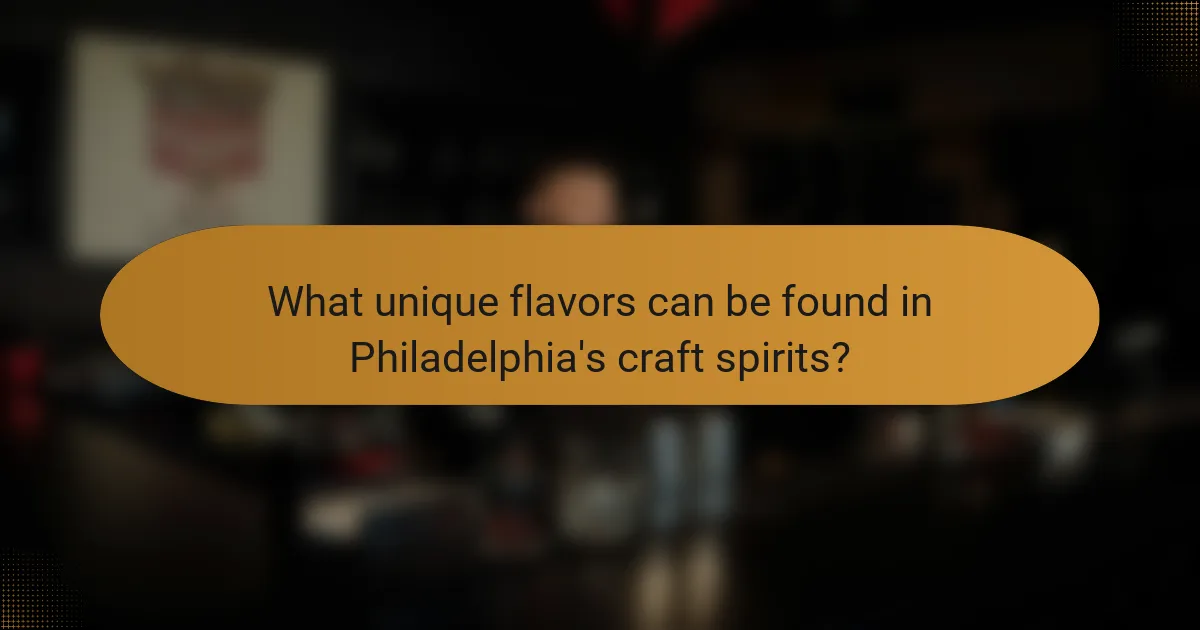
What unique flavors can be found in Philadelphia’s craft spirits?
Philadelphia’s craft spirits feature unique flavors such as honey, citrus, and spices. Distilleries in the area often incorporate local ingredients. For example, honey from nearby farms enhances the sweetness in spirits. Citrus flavors come from locally sourced fruits, adding freshness. Spices like cardamom and cinnamon create complexity in various spirits. Additionally, some distilleries experiment with unique botanicals. This experimentation leads to distinctive flavor profiles not found elsewhere. Overall, Philadelphia’s craft spirits offer a diverse tasting experience.
How do local ingredients influence the flavor profiles?
Local ingredients significantly influence flavor profiles by introducing distinct regional characteristics. These ingredients often carry unique taste notes that reflect the local climate and soil. For example, grains sourced from Pennsylvania may impart a specific earthiness. Similarly, herbs and fruits grown in the region can add freshness and vibrancy. The use of local botanicals in spirits enhances authenticity. This connection to the land creates a sense of place in each sip. Additionally, local ingredients often align with seasonal availability, affecting flavor variations throughout the year. Studies show that consumers appreciate the connection between local sourcing and flavor complexity.
What are some signature flavors that define Philadelphia craft spirits?
Philadelphia craft spirits are defined by signature flavors such as rye, apple, and honey. Rye whiskey showcases a spicy and robust profile, reflecting the region’s historical grain production. Apple brandy highlights local apple varieties, offering a fruity and aromatic essence. Honey-infused spirits bring a natural sweetness, often sourced from local beekeepers. These flavors are enhanced by the city’s diverse culinary influences. Distilleries like Philadelphia Distilling and New Liberty Distillery exemplify these unique profiles. Their products often win awards, reinforcing Philadelphia’s reputation in the craft spirits scene.
How do seasonal offerings impact flavor variety?
Seasonal offerings significantly enhance flavor variety in local craft spirits. Distilleries often create unique blends that reflect seasonal ingredients. For instance, summer may feature citrus and floral flavors, while winter could highlight spices and rich fruits. This approach allows distilleries to utilize fresh, local produce at its peak. Seasonal offerings also attract consumers seeking new experiences. According to industry reports, limited-time flavors can drive sales and customer engagement. This strategy fosters creativity among distillers, resulting in innovative products. Overall, seasonal offerings diversify the flavor profiles available to consumers.
What innovative techniques are used in crafting these spirits?
Innovative techniques used in crafting local spirits include the use of unique fermentation methods. Many distilleries employ wild fermentation, utilizing native yeast strains for distinct flavors. Additionally, some distillers experiment with barrel aging in various wood types. This technique enhances the complexity of the spirits. Vacuum distillation is also utilized, allowing for lower temperature distillation. This preserves delicate flavors and aromas. Furthermore, infusion techniques with local botanicals create signature profiles. These methods reflect Philadelphia’s rich culinary heritage. Each technique contributes to the overall uniqueness of the spirits produced.
How do distillers experiment with aging processes?
Distillers experiment with aging processes by using various types of barrels and aging conditions. They may select different wood types, such as oak or cherry, to influence flavor. Distillers also vary the char levels on barrels, which affects the extraction of compounds. Some distillers test different aging durations, ranging from a few months to several years. Temperature and humidity variations in storage environments are also manipulated to observe their effects. Additionally, they may blend spirits aged in different barrels to achieve unique profiles. These methods allow distillers to refine flavors and enhance the overall quality of their spirits.
What role do local collaborations play in flavor development?
Local collaborations significantly enhance flavor development in craft spirits. These partnerships often involve local farmers, foragers, and artisans. They provide unique ingredients that reflect regional characteristics. For example, distilleries may source local grains or botanicals. This practice fosters innovation and creativity in flavor profiles. Collaborations also strengthen community ties and promote local culture. Furthermore, they can lead to exclusive products that attract consumers. The distinctiveness of these flavors often boosts the appeal of local craft spirits.
Local craft spirits in Philadelphia encompass small-batch alcoholic beverages produced by local distilleries, including gin, whiskey, rum, and vodka, crafted with traditional methods and locally sourced ingredients. The article highlights the differences between craft and mass-produced spirits, emphasizing quality factors such as ingredient sourcing and production techniques. It explores the historical context of Philadelphia’s distilling culture, local regulations, and the unique offerings of must-visit distilleries. Additionally, the article discusses tasting experiences, innovative flavor profiles, and the impact of local collaborations on the craft spirits landscape in the city.
